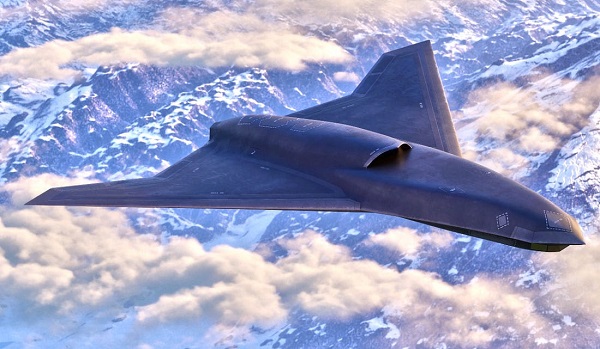International
Freeland hints nukes from France, Britain can protect Canada from the Trump ‘threat’

From LifeSiteNews
‘The U.S. is turning predator and so what Canada needs to do is work closely with our democratic allies, our military allies,’ Freeland said last week, adding that ‘I would be sure that France and Britain were there, who possess nuclear weapons.’
Former finance minister and and current Liberal Party leadership race hopeful Chrystia Freeland suggested last week that Canada should have the protection of British and French nuclear weapons to deter U.S. President Donald Trump and his “51st state” comments.
During the February 25 English-language Liberal Party leadership debate, Freeland, who is running for party leadership to replace Prime Minister Justin Trudeau after serving in his cabinet for a number of years, claimed that Canada should work with allies who have nuclear weapons, like France and the United Kingdom, to protect against U.S. President Donald Trump’s threat to turn the nation into the 51st U.S. state.
“The U.S. is turning predator and so what Canada needs to do is work closely with our democratic allies, our military allies,” Freeland stated last week.
“I would start with our Nordic Partners specifically Denmark, which is also being threatened and our European NATO allies,” she continued. “I would be sure that France and Britain were there, who possess nuclear weapons.”
“I would be working urgently with those partners to build a closer security relationship that guarantees our security in a time when the United States can be a threat,” Freeland declared.
Freeland’s suggestion has been roundly condemned and ridiculed by Canadians online. LifeSiteNews’ Editor-in-Chief John-Henry Westen responded to her statement, saying that “this is not the Canada that most of us are a part of.”
“The great majority of Canadians love Canada and love the counter-revolution of common sense going on in the United States,” he declared. “We hate the Canada that Trudeau represents.”
A few days after Freeland’s speech, Trump called the Liberal leadership candidate a “whack” during an interview with the Spectator.
“She’s absolutely terrible for the country,” Trump said. “She’s incompetent in many respects and can only cause ill will for Canada. In fact, Governor Trudeau understood that.”
“And he actually fired her because of a meeting he had with me. I said, ‘she is so bad. She’s bad for the country,’” he continued.
As LifeSiteNews previously reported, later in the speech, Freeland advocated for “democratic” countries to “build a New World Order,” again, allegedly to combat Trump’s threats.
“I don’t think any of us wants to be the leader who was asleep at the wheel and didn’t get Canada defended, did not work with our democratic allies to protect our borders,” she said.
“They want to work with us it’s time for us to step up at home to urgently reach out to them and build a New World Order where democracy and Canadian sovereignty is protected,” Freeland declared.
Media outlets have long described talk of a “New World Order” as a conspiracy theory, but globalist organizations such as the World Economic Forum (WEF) and the United Nations (UN) continue to give credence to the concept, by publicly calling for and working towards a worldwide “Great Reset” or other similarly named agendas.
During the last few years, during which time Freeland has served as deputy prime minister and finance minister, the Liberal Party has routinely come under fire for its ties to globalist organizations like the WEF.
In fact, Freeland’s own ties to the WEF seem extensive, with her receiving a personal commendation from former WEF leader Klaus Schwab.
Others have also pointed out that right around the time she announced her bid for Liberal leader, the WEF’s profile on Freeland disappeared from the group’s website.
Another Liberal leadership candidate, Mark Carney, also has ties to the WEF, as does outgoing Prime Minister Justin Trudeau.
Focal Point
White House Announces Tylenol–Autism Link, Opens Door to Vaccines

The pathway to developmental regression begins with vaccines, not acetaminophen.
In a MAJOR development, both Trump and RFK Jr. also acknowledged the possibility that vaccines contribute to autism. As Trump said:
“They pump so much stuff into those beautiful little babies, it’s a disgrace.”
Although most of the spotlight fell on Tylenol, the evidence is undeniable: acetaminophen is NOT the root cause. At most, it weakens defenses and heightens vulnerability. The true trigger — then and now — is VACCINES.
The Evidence
Prenatal Exposure
The most comprehensive review to date, by Prada et al, evaluated acetaminophen use during pregnancy:
- 27 studies found a positive association with neurodevelopmental disorders (ASD/ADHD).
- 9 studies showed no link.
- 4 studies suggested protective effects.
Autism was never diagnosed at birth. In every study, it emerged years later—typically ages 2–8, the very same window when children are loaded with a battery vaccines. None of these papers accounted for vaccination as a confounder. This shows prenatal Tylenol exposure may predispose children, but the neurological injuries are detected during the vaccine years.
Postnatal Exposure
Schultz et al (2008): Children given Tylenol after MMR vaccination were about six times more likely to later be diagnosed with autism. In those who regressed (lost previously acquired skills), the risk was nearly fourfold, and in those with clear post-vaccine complications, the risk spiked to over eightfold. By contrast, ibuprofen showed no association.
Yengst et al (2025): In a Medicaid cohort of 674,000+ children, repeated episodes of fever, ear infections, or other “Tylenol-triggering” illnesses were linked to a 2½-fold higher risk of autism. Among girls with multiple fevers, the risk climbed to nearly fourfold.
Taken together, these studies reveal a consistent pattern: autism risk intensifies in the post-vaccine period, when febrile reactions are most common, and acetaminophen use in this context may amplify the likelihood of developmental regression.
Acetaminophen depletes glutathione, the body’s master antioxidant/detox system, exactly when the brain faces inflammatory/oxidative stress (e.g., fever, seizure, immune activation). Some pediatric practices have even recommended Tylenol before vaccine visits “just in case,” meaning kids arrive with defenses already depleted as the shots provoke fever/immune activation—priming them for worse outcomes.
Confounding by Indication
Tylenol is rarely given at random. It is usually given because a child has spiked a fever or suffered a seizure — often after vaccination. This creates what’s known as confounding by indication: the very reason for giving Tylenol (a serious post-vaccine reaction) is already linked to elevated risk.
Across studies, a clear pattern emerges:
- Diagnoses cluster in early childhood (ages 2–8), the most intensive vaccine years.
- Greater fever/illness burden — situations when Tylenol is typically used — corresponds to higher odds of autism.
- Regression subgroups show the largest risks following vaccination (Schultz).
Together, the evidence points to vaccination as the trigger, with Tylenol lowering defenses by depleting glutathione and thereby magnifying the neurologic damage.
Timeline Reality
- Tylenol was released in the 1950s. Autism rates stayed flat.
- The surge began in the late 1980s and 1990s, exactly when the childhood vaccine schedule doubled and tripled.
If Tylenol alone were the driver, autism would have spiked in the 1950s. It didn’t.
The Missing Evidence
- There are no case reports of regression to autism from acetaminophen alone.
- By contrast, there are thousands of parental reports and multiple peer-reviewed studies documenting developmental regression after vaccination.
Nonetheless, today’s announcement has opened the door for an official investigation into the glaring link between childhood vaccination and autism.
At the McCullough Foundation, we are finalizing one of the most comprehensive analyses ever conducted on the causes of autism — untainted by fraud, bias, and corruption. You can rest assured that all risk factors will be included, INCLUDING VACCINES.
No stone will be left unturned — and no protected interest will be spared.
Epidemiologist and Foundation Administrator, McCullough Foundation
Support our mission: mcculloughfnd.org
Please consider following both the McCullough Foundation and my personal account on X (formerly Twitter) for further content.
FOCAL POINTS (Courageous Discourse) is a reader-supported publication.
To receive new posts and support my work, consider becoming a free or paid subscriber.
armed forces
Secretive Lockheed Martin Skunk Works reveals latest high-tech military drone

 THE MAKICHUK REPORT
THE MAKICHUK REPORT
Unmanned Vectis to ride shotgun with next-gen fighters
When Lockheed Martin’s super secret Skunk Works© advanced development arm unveils a new project, the aviation world stops and listens.
As always, it is very hush-hush, and, quite often, groundbreaking.
This week’s announcement didn’t disappoint.
It’s called “Vectis” — a stealthy autonomous drone that Lockheed intends to fly by the end of 2027.
As with most Skunk Works projects, officials declined to comment on certain aspects of the aircraft’s design, such as its engine or top speed, though it was noted that Lockheed’s analysis “doesn’t point toward supersonic [speeds]” as a requirement.
What do we know about it, aside from it’s very cool, futuristic design?
The first Vectis prototype is currently “in progress,” and is envisioned as a large “Category 5” reusable drone designed to be customizable to match shifts in the threat environment, said OJ Sanchez, Skunk Works’s vice president and general manager.
“Vectis provides best-in-class survivability at the CCA [Collaborative Combat Aircraft] price point,” Sanchez told reporters ahead of the Air Force Association’s Air Space and Cyber conference in Washington, D.C. “Prototype parts are ordered, the team is in work, and we intend to fly in the next two years.”
According to Breaking Defense, Lockheed sees the range, endurance and flexibility of Vectis’s design as key to its appeal.
It is being developed for the US and international markets based on feedback from multiple customers about the future battlefield.
One has to only look at the Russia-Ukraine conflict, to see that things have changed.
Vectis can carry out mission sets ranging from air-to-air, air-to-ground and ISR, and has an open systems architecture allowing it to interface with platforms and mission systems not built by Lockheed Martin, Breaking Defense, reported.
Certain aspects of the drone — such as which payloads it can carry, or whether it is optimized for regular operations or used less frequently on deployments — can be fine-tuned to meet a customer’s specific requirements.
For instance, “we will have built into it the ability for it to be a daily flyer, reliably work alongside its crew teammates, to be able to integrate into operations for training, as well as for deployment,” Sanchez said.
“At the same time, if the requirement is ease of storage and ease of assembly, it’s absolutely built into the design. … That’s where we’ll work closely to listen with any individual customers and go from there on their operations choice, but the flexibility is built in.”
With the lessons of Ukraine in mind, Vectis is designed to be maintainable in a deployed environment, with a simple design made of “and durable, reliable materials” and easy access to the aircraft’s internal systems if repairs need to be made.
While it has not flown, Lockheed has conducted operational analysis and simulations that paired the drone with the F-22 and F-35, with Sanchez noting that its low-observable signature and communications gear are “compatible” with fifth- and sixth-generation aircraft.
It was also informed by previous experience designing tailless aircraft like the X-44 MANTA, Lockheed’s sixth-generation fighter prototype for the Air Force’s Next Generational Air Dominance program, Sanchez said.
“We’re building in that kind of autonomy, that flexible autonomy, if you will, so that we can work with more countries, more partners, to really listen to what their needs are,” he said.
“That flexibility has been demonstrated through multiple demonstrations. Now we’ll go out and build it, and we’ll work to prove in the open air.”
In the U.S. military’s parlance, Group 5 uncrewed aerial systems are the largest and most capable, covering anything pilotless with a maximum takeoff weight of 1,320 pounds or more, and that can fly at altitudes of 18,000 feet or higher.
When asked, Sanchez declined to offer any hard dimensions or other specifications for Vectis. He did say it was smaller than a Lockheed Martin F-16 fighter, but larger than one of the company’s Common Multi-Mission Truck (CMMT, pronounced ‘comet’) missile-like drones, which is a very broad size range.
According to experts at TWZ.com, renderings of Vectis from Skunk Works show a tailless drone with a lambda wing planform and a top-mounted air intake.
There is a pronounced chine line around the forward end of the fuselage and a shovel-like shape to the nose, as well as various conformal antennas and/or sensor apertures, all of which are indicative of low-observable (stealthy) design considerations.
A short promotional video also includes a cutaway view showing an S-shaped duct behind the air intake and exhaust shrouding, features that offer further radar cross-section and infrared signature reducing benefits.
Vectis’ core planform is interestingly reminiscent, in some broad strokes, of a rendering of a stealthy aerial refueling tanker concept Skunk Works first showed publicly last year.
That aircraft had a much larger design, in line with its intended mission, with large clipped wings that had some lambda-wing attributes, as well as small outwardly-canted twin vertical tails.
There has been something of an uptick in recent years in new crewed and uncrewed tactical aircraft designs with lambda or at least lambda-like planforms.
This includes one of the several air combat drone designs that emerged around a massive military parade in China earlier this month, as well as one of the two Chinese next-generation crewed combat jets that broke cover in December 2024.
Vectis also has “endurance ranges compatible with Indo-Pacific, European, and CENTCOM [U.S. Central Command] theaters,” according to a Lockheed Martin press release.
What munitions and other payloads Vectis might be able to carry is unclear. Skunk Works’ Sanchez mentioned “reusable or flexible payloads,” but did not elaborate.
The promotional video shows a vignette in which the drones, operating together with an F-22, use unspecified sensors to spot and track aerial threats before being ordered to fire air-to-air missiles, presumably from internal bays, at those targets.
Electronic warfare suites and signal relay packages might also be among the payload options for Vectis drones.
Sanchez did not provide any hard cost metrics for Vectis. The Air Force has said in the past that it is aiming for a unit cost roughly in the US$20 million range for drones being developed under the first phase, or Increment 1, of its CCA program.
In discussing how Vectis could be adaptable to multiple U.S. and foreign operator requirements, Sanchez also spoke in more detail about the drone’s current dependence on traditional runways, as well as its ability to operate from more austere locations.
“Our analysis aligns with the U.S. Air Force, that runway accessibility is incredibly important in every theatre, particularly in INDOPACOM [the U.S. Indo-Pacific Command area of responsibility]. So we’re very intentional about the flexibility that this system would enable in the theaters of interest,” Sanchez explained.
“And so the amount of runways that will be available, the amount of flexibility to implement, whether it be an Agile Combat Employment approach, or a hub and spoke for other countries, depending on how it is, Vectis will be very capable in those spaces.”
Exactly how Skunk Works envisions the Vectis will handle counter-drone weapons, such as Israel’s Iron Dome, Iron Beam, or David’s Sling, remains uncertain.
THE MAKICHUK REPORT is free today.
You can tell THE MAKICHUK REPORT that their writing is valuable by pledging a future subscription.
You won’t be charged unless they enable payments.
-

 Business2 days ago
Business2 days agoCarney’s ‘major projects’ list no cause for celebration
-

 Business2 days ago
Business2 days agoGlobal elites insisting on digital currency to phase out cash
-

 Business2 days ago
Business2 days agoRed tape is killing Canadian housing affordability
-

 Health2 days ago
Health2 days agoMAiD should not be a response to depression
-

 Artificial Intelligence2 days ago
Artificial Intelligence2 days agoUK Police Chief Hails Facial Recognition, Outlines Drone and AI Policing Plans
-

 Business1 day ago
Business1 day agoOttawa’s so-called ‘Clean Fuel Standards’ cause more harm than good
-

 Business1 day ago
Business1 day agoThe Truth Is Buried Under Sechelt’s Unproven Graves
-

 International2 days ago
International2 days agoFrance records more deaths than births for the first time in 80 years















